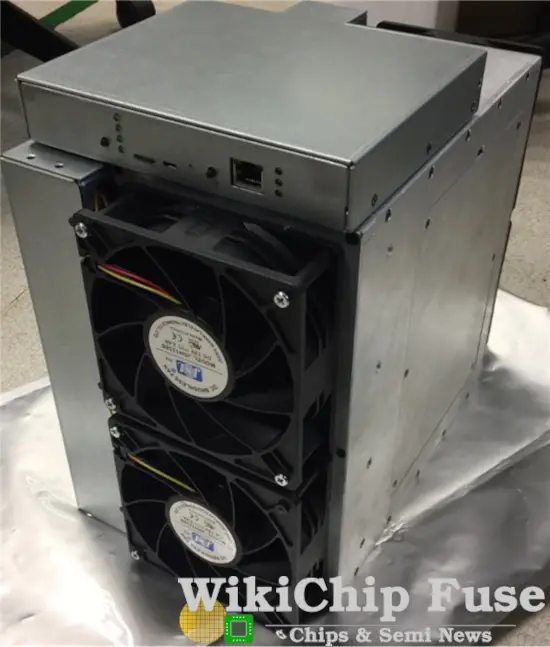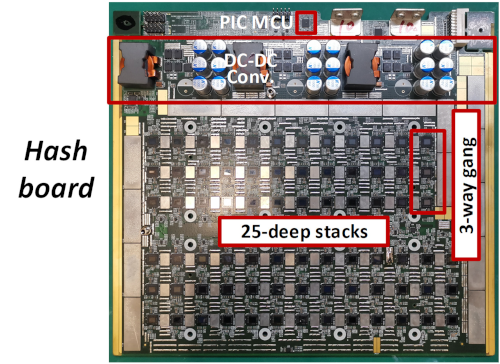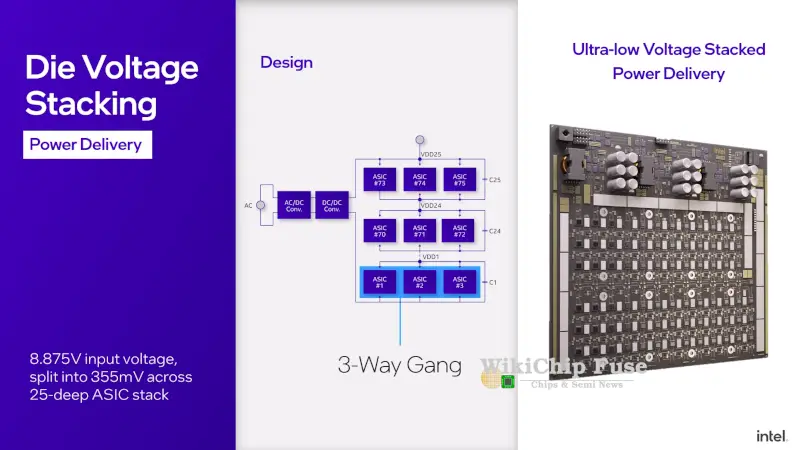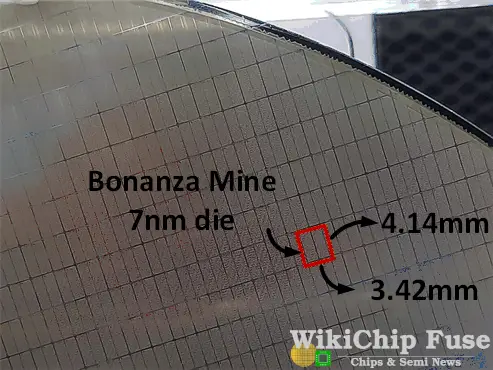Intel Unveils BonanzaMine, A Bitcoin Accelerator ASIC
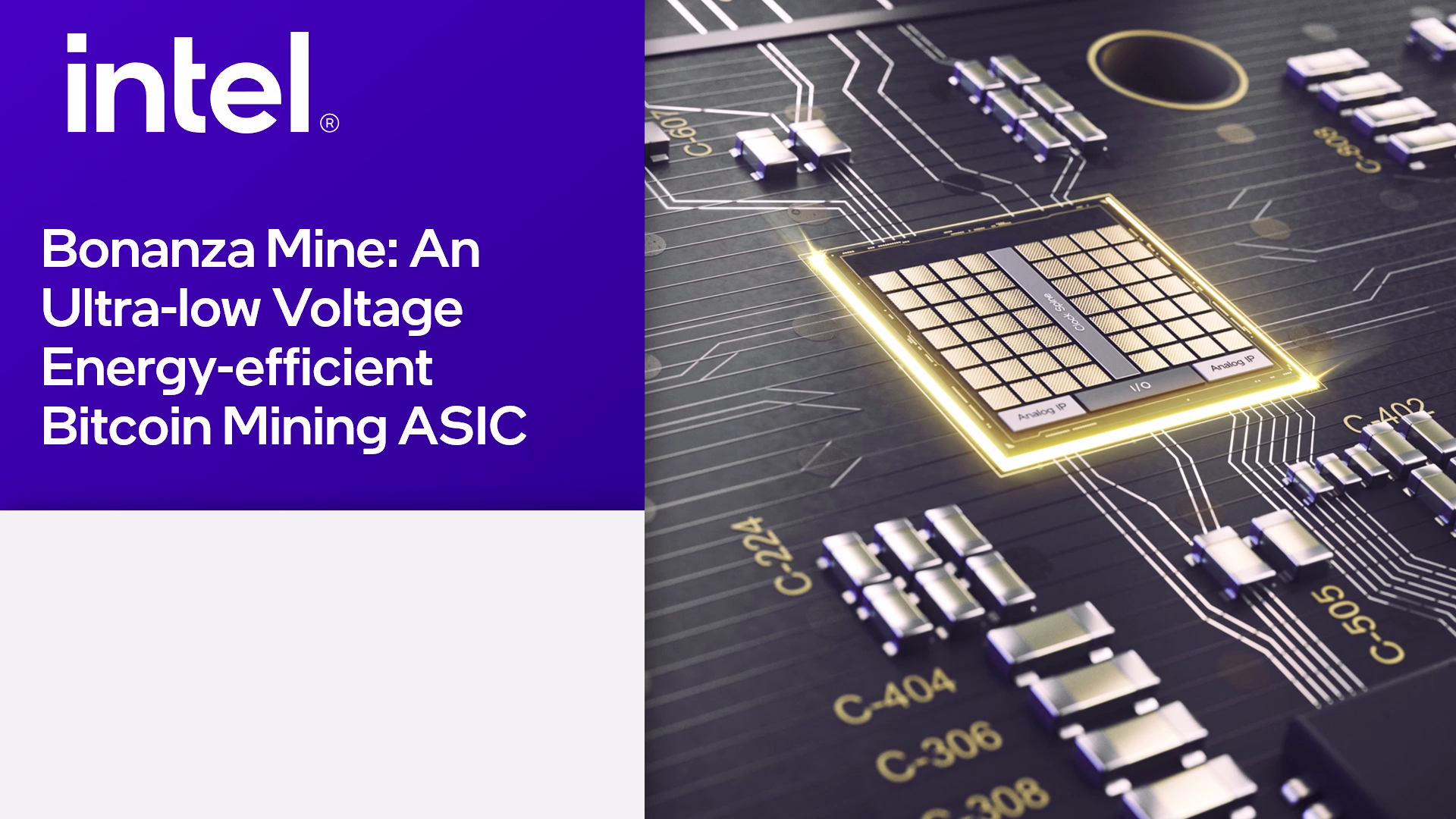
A few years ago Intel announced its XPU effort which entails the diversification of their compute silicon through specialized architectures. More recently Intel formed a new Custom Compute Group within the Accelerated Computing Systems and Graphics (AXG) business unit with the objective of building custom silicon platforms optimized for customers’ workloads. At the 2022 IEEE International Solid-State Circuits Conference (ISSCC) which is taking place virtually this week, the company unveiled BonanzaMine, its first-generation blockchain accelerator ASIC effort. The full system incorporates 300 BonanzaMine ASICs and is said to achieve 40 THash/s at 3600 Watts.
Bonanza Mine System
Intel incorporates all the necessary components into a single self-contained computer called the Bonanza Mine System which looks fairly similar to most other miners out there. Each system incorporates four hash boards, an Intel FPGA control unit, four fans, and a programmable power supply. The photo below is that of the complete reference system. The four boards are behind the fans while the control unit is the component at the top and the power unit is sitting vertically attached to the left.
The upper portion of the system contains the control unit which is an Intel FPGA with a hard ARM cortex core that hosts the mining daemon. It orchestrates the deployment of mining workloads, programs the PLLs, and verify results. Communication with mining pools is done over the Ethernet link. Communication with all the individual BonanzaMine ASICs is done via UART and I2C links which go to each of the individual hash boards.
Each board incorporates 75 BonanzaMine ASICs organized as a 25-deep voltage stack. The individual BonanzaMine chips are daisy-chained with a 10Mb/s UART serial link that goes back to the control unit for mining payload/workload communication. There is also an MCU on each board for the monitoring of thermal and voltage.
For the power delivery to the ASICs die voltage stacking is utilized. This is taking advantage of the fact that all the ASICs exhibit highly uniform nominal voltage and current characteristics. The 75 BonanzaMine ASICS within each board is organized as a 25-deep stack with every three ASICS each being ganged stack voltage. That allows an input voltage of 8.875 V to be divided into 355 mV across each ganged ASICs group. Intel says this provides a 5% improvement in mining efficiency as well as improves IR drop losses.
BonanzaMine ASIC
The BonanzaMine die is 4.14×3.42 mm in size or 14.16 mm² and is fabricated on a 7-nanometer process (Intel did not disclose whose 7 nm they are using). With 300 of them in a system, that’s 4,248 mm² of silicon. It is optimized for Bitcoin which means the ASIC basic building block is the double SHA256 hash engines. For those engines, Intel designed a 120-round fully unrolled SHA256 datapath. By leveraging several Bitcoin-specific optimizations (e.g., pre-compute of static fields, iterate start nonce, and early termination), 8 rounds are said to be eliminated, reducing the engine area by around 8%. Additionally, to reduce power, all flip-flops in the SHA256 datapath were also replaced by 3-phase latch-based clocking using level-sensitive latches. This is said to result in up to a 50% reduction in sequential and clocking power. To further save on energy, a half-frequency scheduler that implements two parallel scheduler datapaths was also utilized. This is said to provide 10% higher energy efficiency.
There are 258 mining engines integrated into each BonanzaMine die. Several precomputed intermediate (as well as incremented start nonce) hashes are computed at the system controller, eliminating four compute rounds from the mining engines. The intermediate hash values are sent to individual engines to brute-force double-hash search across all 2e32 potential nonces for a golden nonce based on a 2e224 share target. When an engine hits on a golden nonce, it is reported back to control for verification. Two additional rounds of hashing are necessary at that point to compare to the block target. With each of the 258 engines programmed with a unique hash value from candidate Merkle root, there are 19,350 simultaneous workloads processed per board and 77,400 workloads operating simultaneously at the system level.
Intel says the engines account for 90% of the die area. The other 10% is for the lower portion of the die, ‘the notch’, which incorporates the PLL, sensors, and GPIO. The individual mining engines operate at just 355 mV. The notch area operates at 750 mV. The BonanzaMine has shown reliable operations of 1.35-1.6 GHz at 355 mV.
While Intel currently demonstrated a relatively large system, the use of small chips certainly opens up the possibility for smaller systems (‘mini-miners’), a market segment that currently lacks competitive products.
At 1.35-1.6 GHz, the BonanzaMine generates 116 GHash/s to 137 GHash/s at an average power of 7.5 W. This works out to 54.8 J/THash. At the system level, with 300 BonanzaMines, Intel says the specialized computer demonstrates 40 THash/s at 3600 Watts, although the system can achieve higher rates. At their presentation, Intel compared the BonanzaMines to the Bitfury Clarke and Canaan Avalon A9. At 47.7 TH/s, the BonanzaMines System is shown achieving 55 J/TH whereas the Bitfury Clarke achieves 40 THash/s at 56 J/TH while the Canaan Avalon A9 does 30 TH/s at 58 J/TH.
Because this was a technical presentation and not an actual product announcement, no pricing or availability information was provided. However, earlier this month, in an opinion piece published on the Intel website, Raja Koduri, SVP and GM of AGX Group, said “Our blockchain accelerator will ship later this year. We are engaged directly with customers that share our sustainability goals. Argo Blockchain, BLOCK (formerly known as Square) and GRIID Infrastructure are among our first customers for this upcoming product. This architecture is implemented on a tiny piece of silicon so that it has minimal impact to the supply of current products.”
–
Spotted an error? Help us fix it! Simply select the problematic text and press Ctrl+Enter to notify us.
–

